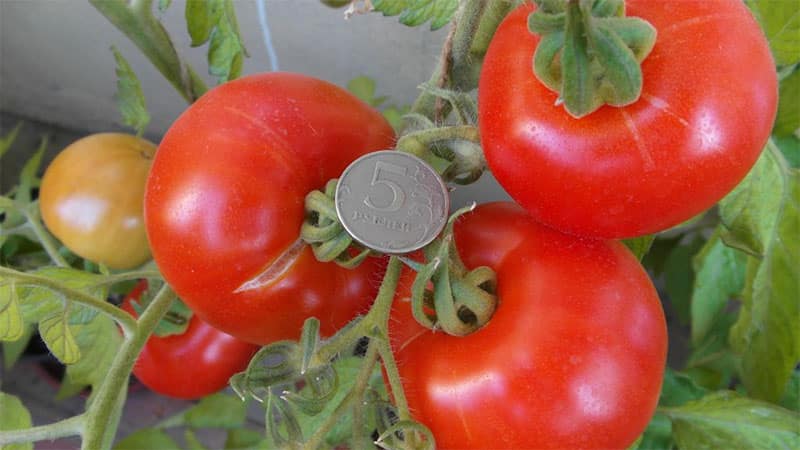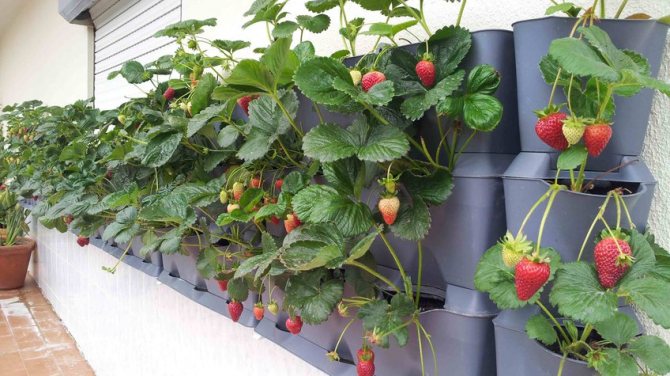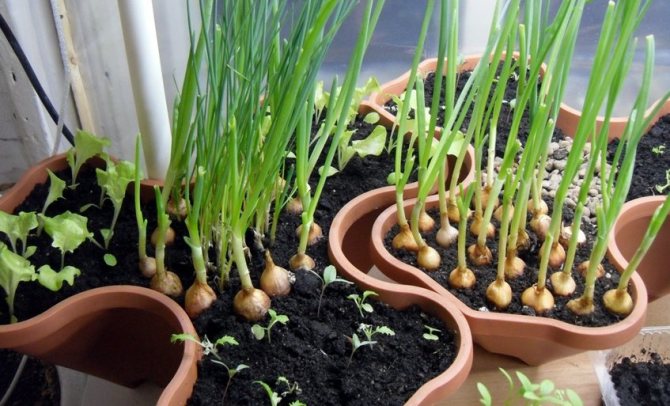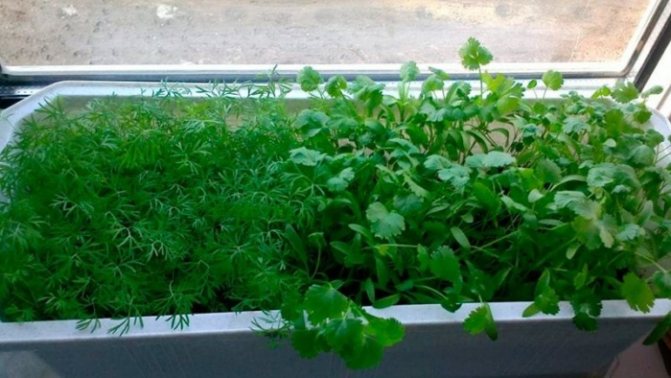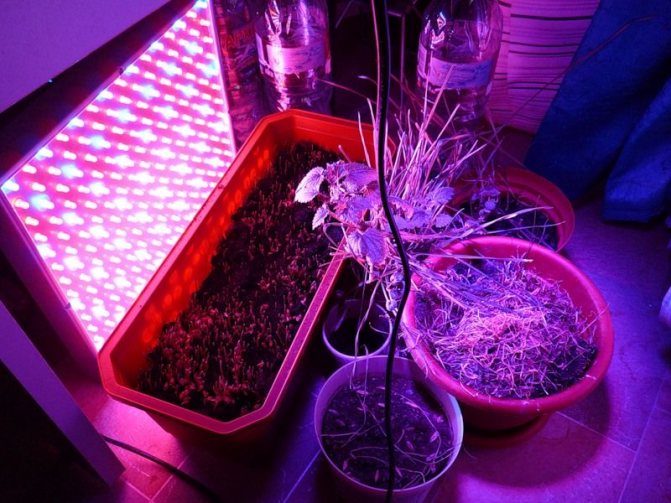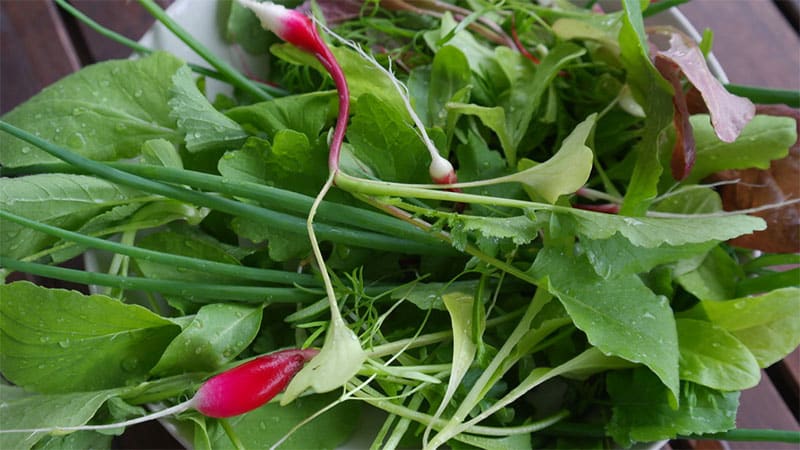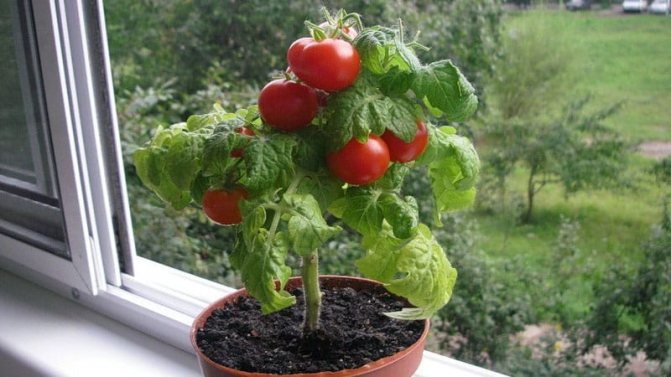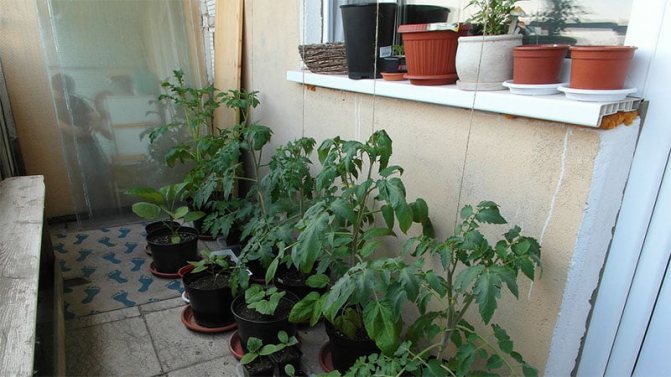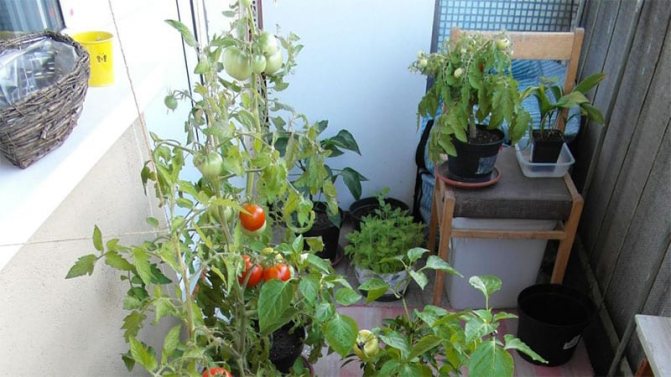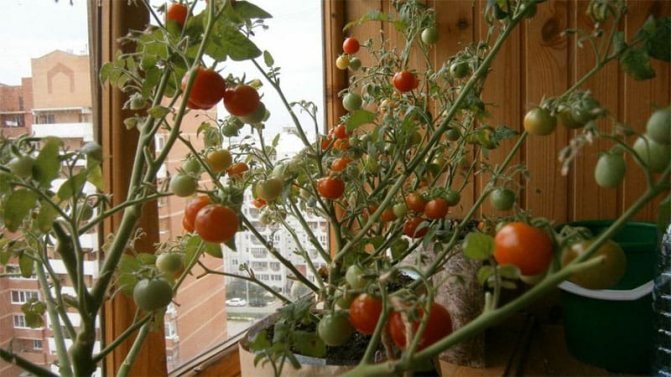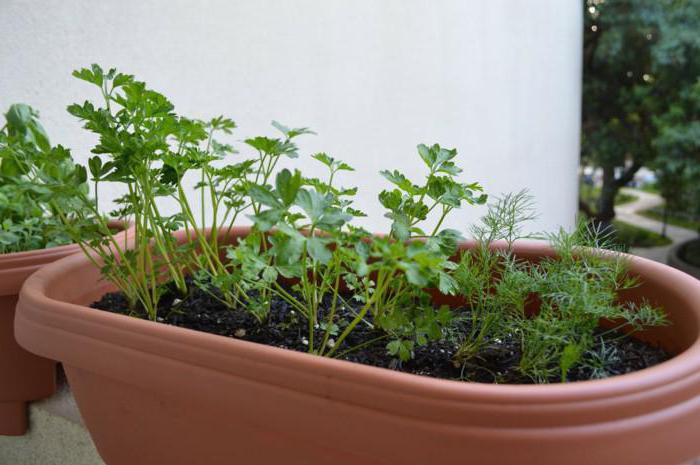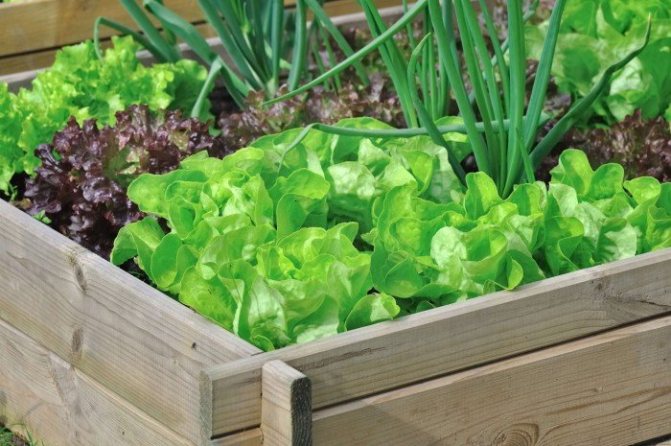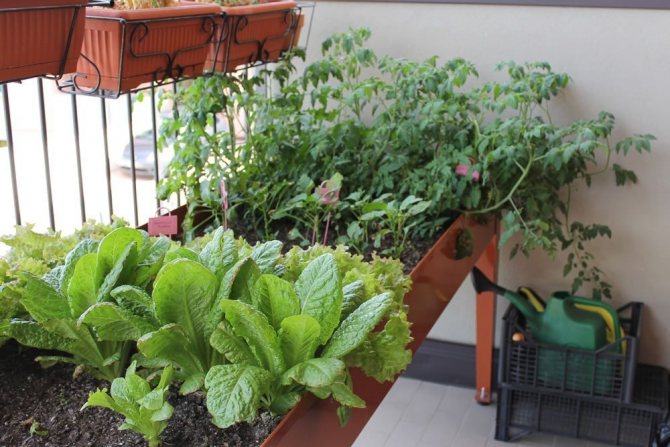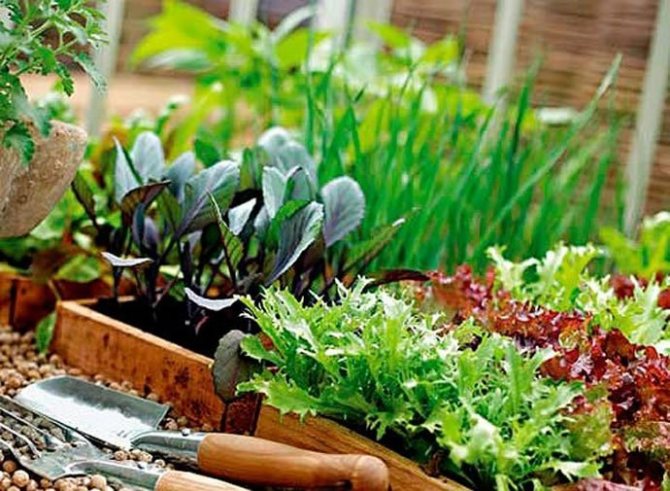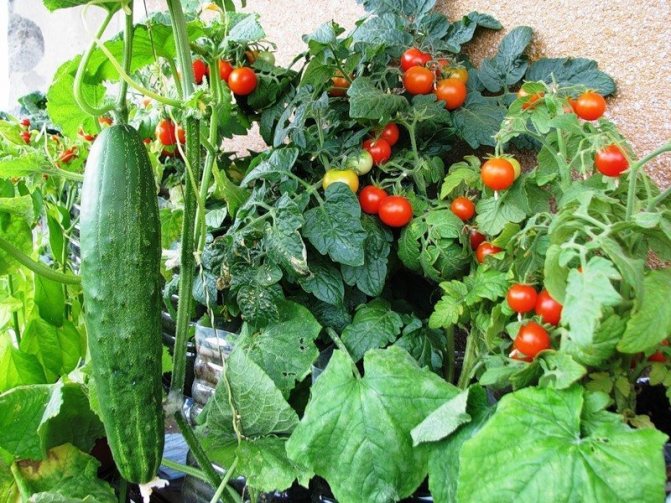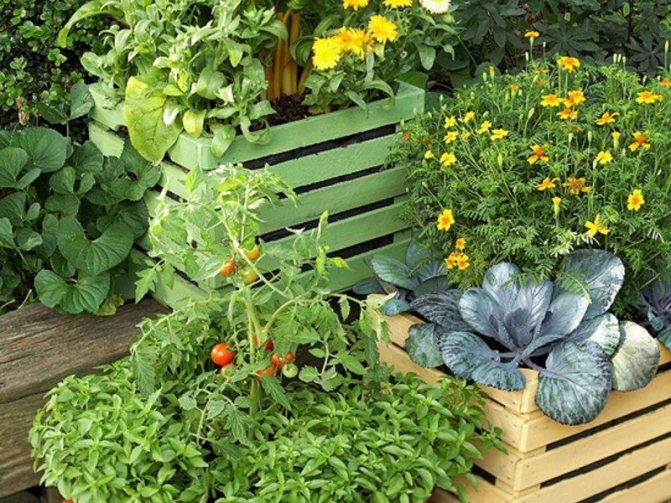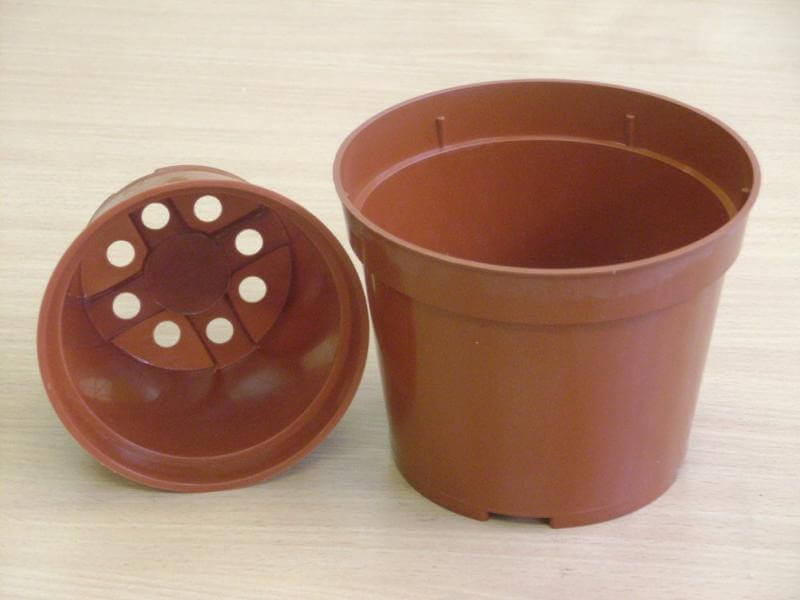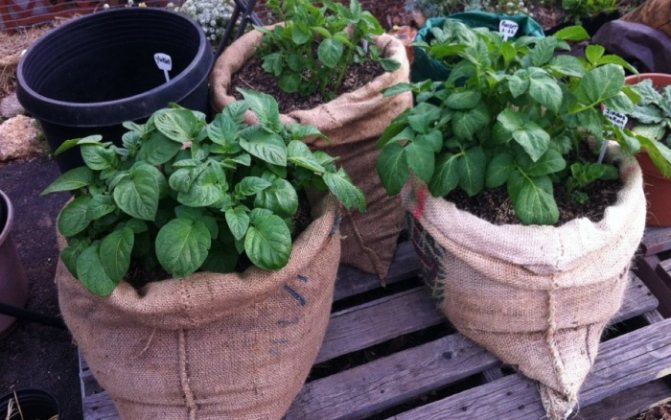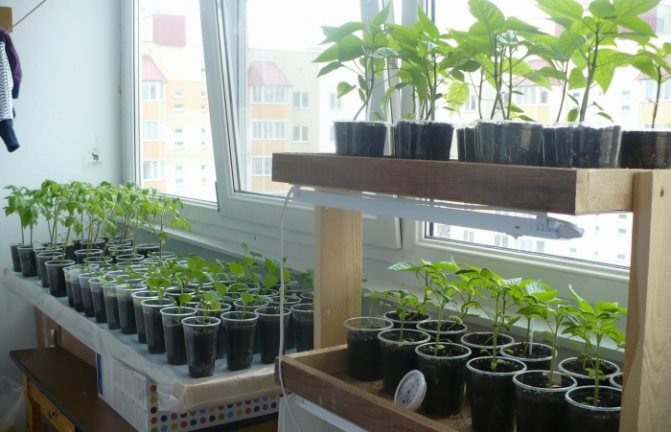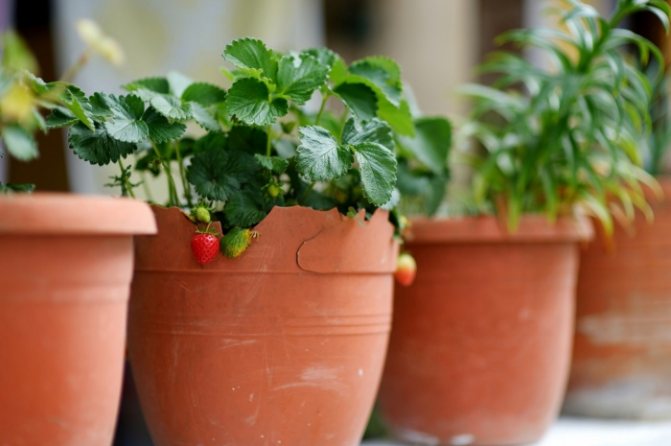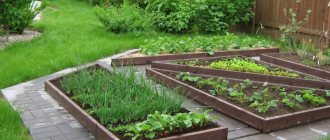Now we are becoming more careful in our food choices, especially from an environmental point of view. And this is the right decision, since human health depends directly on the type of food. Many people prefer to grow fruits and vegetables in their gardens or summer cottages. If you like fresh and tasty food, you like growing plants and flowers, then it will not be difficult for you to organize a vegetable garden on the balcony.
What to plant on the balcony - varieties of greens and vegetables
Having wondered how to build home beds, consider what purpose you are pursuing? Decorate the balcony and at the same time enrich the family menu without spending too much time on caring for the garden? Then pay attention to the various varieties of greenery, which are distinguished by their decorative appearance, unpretentiousness, and useful composition:
- onions on a feather - onions, chives, onions;
- salad - "Odessa (curly)", "Snowflake", "Maisky", watercress;
- parsley - "Beads", "Fitness", "Emerald Lace";
- basil - "Clove aroma", "Thai queen", "Green aroma";
- other types of spices - chervil, chard, coriander, celery, mint.

Basil can be grown in a pot
Would you like to surprise your guests with a vegetable salad made from fragrant freshly picked fruits in winter? Prepare for the significant day in advance - plant several seedlings of tomatoes, cucumbers, peppers. The main thing is to choose low-growing varieties so that the containers with them are stable, and you do not fiddle with the props. If you do not want to buy ready-made seedlings, stock up on seeds for organizing a garden on the balcony:
- hot peppers - Ogonyok, Serpent Gorynych, Superchili;
- cherry tomato - Kishmish, Mikron-NK, Cascade Red, Cherripals;
- cucumbers - Courage, Pallas' cat, Balcony miracle;
- sweet paprika - Watercolor, Carat, Treasure Island.
Climbing plants also look impressive, so for the sake of beauty and benefit, you can be puzzled by planting beans or peas. And if cultivating a vegetable garden seems to be a routine task, pay attention to berries - strawberries, currants, blueberries. Some enthusiasts in a confined space manage to successfully grow raspberries, physalis, figs.


Pomegranate on the balcony
Experienced gardeners often arrange a research mini-nursery on the balcony. There, they observe exotic plants, so that they can then fearlessly relocate to a personal plot or to a full-fledged greenhouse. As a result, it becomes possible to grow such unusual fruits as bananas, kiwi, persimmons and even coffee beans in a temperate climate.
How to turn a balcony into a mini garden
This is a simple matter for beginners on the balcony, and people who have devoted years to gardening understand that the harvest will not grow so easily. It is necessary to provide the chosen culture with optimal conditions for its growth and fruiting:
- composition and heating of the soil,
- lighting mode, watering, replenishment,
- air temperature, humidity, air exchange rate.
To maintain these parameters in an acceptable ratio, first prepare the balcony:
- Seal gaps in corners and walls to minimize drafts.
- Refresh the glazing beads and put putty on the joints if you find the windows are leaking.
- Is the floor covering strong enough to withstand the additional stress? Protect it with thick linoleum if necessary.
If you have already glazed and insulated the balcony, perhaps you even heat it, nothing will prevent you from equipping a vegetable garden here for early and late cultivation of crops. Many varieties, for example, mini-tomatoes, are able to actively bear fruit at relatively low temperatures and short daylight hours until the New Year. True, they still need additional lighting, so they will have to supply electricity to the loggia and connect an outlet.
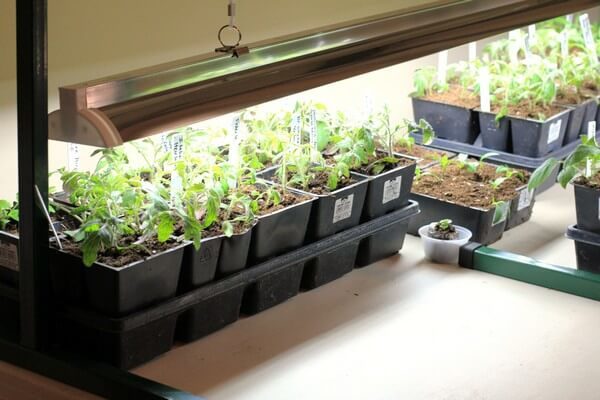

Supplementing tomato seedlings
Additional measures may be needed for the full functioning of the balcony space in the new status:
- installation of a windscreen on the side from which the wind often blows;
- installation of shading devices and materials - visor, umbrella, awning, mirror film;
- expansion of the usable area due to shelves, window sills, tubs, trellises, etc.
You can make a garden with your own hands on an unglazed balcony, open to all winds and elements, in late spring and summer. During this period, sudden vagaries of the weather are unlikely. Nevertheless, you will provide for how to protect young seedlings in the event of force majeure. For example, you can wrap them up in a dense (60–80 g / m2) spunbond or bring them into the room.
Arrangement of premises
The conditions on a closed balcony resemble an unheated veranda or greenhouse. Glass traps the sun's rays, so the temperature in such structures is higher than outside, and the plants are not afraid of slight frosts.
On balconies, the lighting is better than in the room and loggias, since sunlight comes from 4 sides at once. The limited internal volume makes it possible to maintain a high, in comparison with living rooms, atmospheric humidity. The absence of a ceiling makes it possible to grow long vines: cucumbers, legumes, indeterminate tomatoes.
To grow vegetables on a balcony, you need to equip it. On a medium-sized loggia, the growing area ranges from 1.5 sq. m. Hanging shelves and trellises can be placed here. The lightest place is used for vegetables. Citrus fruits and boxes with herbs are placed in the back of the balcony.
Most of the plants on the balcony are kept on shelves. They are assembled from wooden planks, placing several horizontal shelves on vertical supports.
For vines, you have to arrange trellises. They can be vertical or horizontal. The former are suitable for tall tomatoes and cucumbers, the latter for bush vegetables.
The tapestries can be positioned along the side or transverse sides of the balcony. For indoor growing, pots with a mobile trellis are convenient, which are attached directly to the container. These containers can be carried along with the plants.
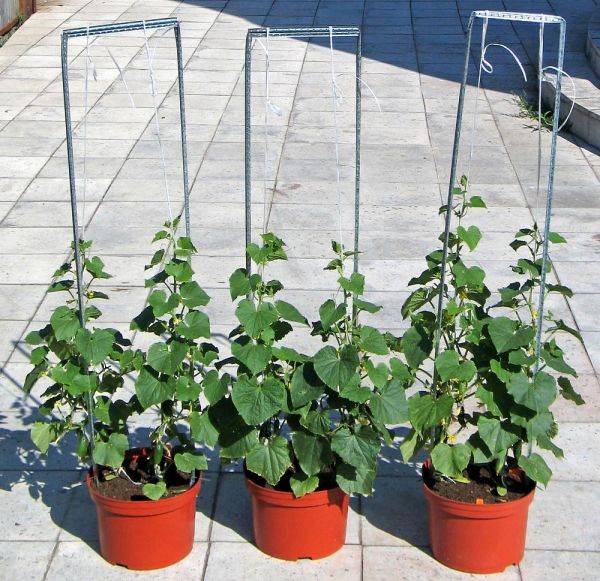

For the installation of horizontal trellises, wooden slats are fixed on window slopes every 20-30 cm.
Plants on the balcony are unlikely to need additional lighting. In cases where it is needed, fluorescent or LED lamps are used. The best option is to buy special phytolamps that give light to the spectrum that plants need.
What to grow - the choice of containers and soil preparation
To keep your crops comfortable in a confined space, make sure you have large enough containers for them. It can be:
- rectangular boxes for seedlings;
- round flower pots and flowerpots;
- hanging and floor pots;
- leaky pots, basins, buckets;
- water pipes, barrels, water bottles, construction bags.
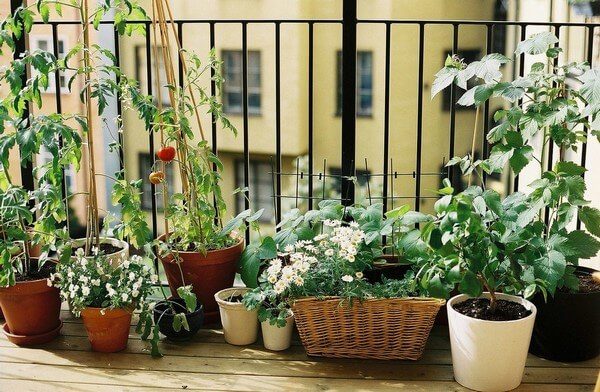

A wide range of options for a mini-vegetable garden
Do not skimp on the volume and density of the arrangement of containers - due to a lack of space, the plants begin to hurt, as a result, their decorative effect deteriorates, and the quality of the crop decreases.For one adult plant, cucumbers and peppers need a 5 liter container, ordinary tomatoes and eggplants need 10 liters, and mini tomatoes grow well in 2 or 3 liter pots.
To grow spicy herbs, the easiest way is to "break" a vegetable garden on the balcony windowsill - here it will be light for them, and it is convenient to take care of them. For forcing onion feathers, you can do with plastic cups or mayonnaise jars filled with water or soil. Large containers - at least 20 cm in width and depth - are necessary for cultivating root crops such as beets, carrots and celery.
As for the soil, due to the limited volume, special requirements are imposed on it:
- fertility,
- absence of pests,
- moisture and air permeability.


The soil mixture must be loose
It is better to buy a soil mixture suitable for a home garden in a specialized store or, in extreme cases, prepare it yourself from ingredients prepared in a timely manner and mixed in the following ratios:
- peat, sod land, humus, mullein - 5: 1: 3: 1;
- humus, sod land - 2: 1;
- humus, mullein, sod land - 7: 1: 2;
- compost, coarse river sand, humus - 1: 1: 2 (plus add two glasses of ash to every two buckets of the mixture).
Make sure to make slots in the bottoms of the containers to drain excess water. Lay a drainage layer on the bottom - expanded clay, perlite, clay shards, coarse gravel, pieces of foam. Then fill up with nutritious soil and leave for a few days. When the soil is compacted (do not specifically tamp), fill up to the top and you can start planting seeds or seedlings.


Expanded clay for drainage
By bitter experience
I hasten to share with you the lessons that I learned from my own experience of growing a garden on a loggia:
- Even balcony plants can suffer from pests and diseases. To avoid the use of chemicals, I recommend planting healthy flowers such as marigolds, rue and lavender. They drive away pests with their aroma.
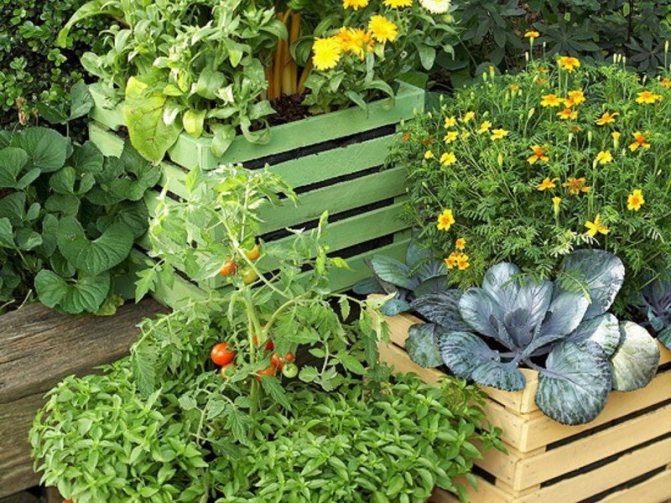

Marigolds are reliable helpers in pest control
- Don't skimp on the size of the planting container. I brought out the optimal size for my loggia (1.7x5 m) - two hanging pots 15x55x10 cm, one stationary pot 15x30x10 cm and several free-standing pots. In this area, there are spicy herbs, hot dwarf peppers, cherry tomatoes and a couple of bushes of undersized beans.
- Read the variety description carefully, remembering that they must all be self-pollinating..
The subtleties of growing different crops
Why, with all the seeming ease of the idea with a garden on the balcony, not everyone succeeds, and instead of generously fruiting bushes, someone grows semi-dry wattle fences, sadly hanging from the windowsill? The main mistake is neglecting the nuances of the workflow. Pay attention to what kind of care a particular plant requires, and follow the recommendations exactly.
Growing lettuce in a container
If you still have not decided what to plant first in the balcony garden, heed the advice - sow a salad, it is the easiest to cultivate. It is worth starting the "sowing campaign" at the end of April, if you have a balcony on the south side, and at the beginning of May - if on the north. Buy seeds from a trusted company - if you are not sure, ask experienced summer residents where they usually shop.


Lettuce seeds
Immediately decide on the right amount: for 1 medium pot you need 10–15 seeds, they are planted in a box with a step of 3 cm. Usually, 1 sachet is enough for a novice gardener. Next, prepare the seed material:
- Prepare a light pink solution of potassium permanganate water.
- Open the package of seeds and separate the required amount.
- Wrap them in a piece of cloth or gauze.
- Dip the seed bag in the manganese solution and leave it for 1 hour to decontaminate.
Plant the pickled seeds in the prepared soil:
- Make a 1–1.5 cm depression in the ground - there are several holes in the pot, and in the box there is a central groove along the entire length.
- Gently place a couple of seeds on the bottom of each hole.
- Fill them with soil, pour abundantly with settled water and cover with polyethylene until the first shoots appear.
If the balcony is still cool, keep your garden in a warm, shaded area. Within 3-5 days, you can see young fragile sprouts, which means it's time to remove the film and moisten the soil. Please note that the salad does not like heat and perfectly tolerates coolness. As soon as the temperature on the balcony thermometer reaches 16-18 °, take the containers out of the living space without hesitation.
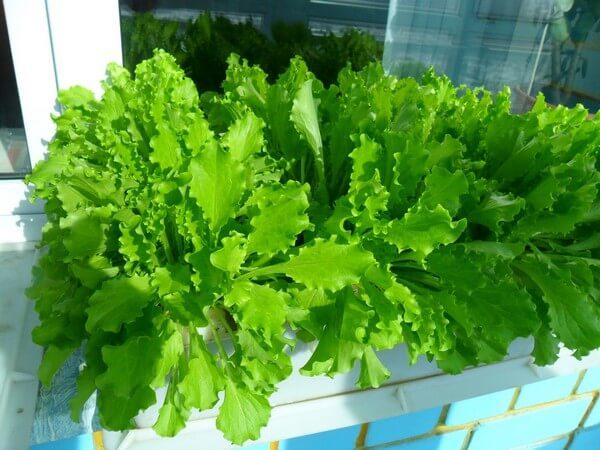

Outdoor salad
Do not forget to water the salad sprouts daily and additionally spray the leaves - without moisture they become bitter and tough. If cool days come, organize watering a little less often - every other day. There is no need to feed the plant, unless you reuse the soil to plant new seeds. In this case, 2 weeks after germination, organize feeding with complex fertilizer for greenery.
How to grow tomatoes on the balcony
Before you arrange a garden of tomato bushes on the balcony, you need to stock up on seeds or seedlings of a suitable variety. It is advisable in the fall, on the eve of frost, to dig up several strong bushes: on the insulated balcony they will be able to bear fruit for another month or a month and a half, and on a soundly insulated and heated one - until spring.
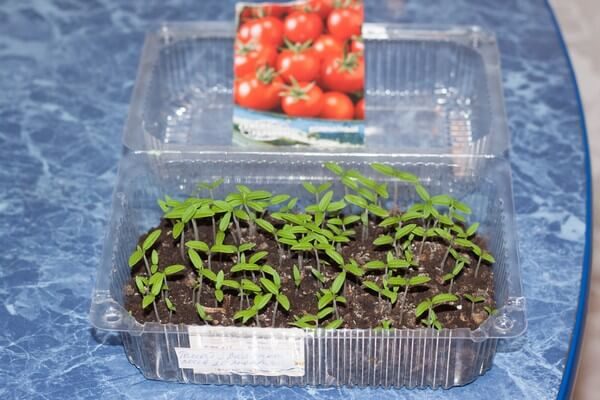

Young tomato seedlings
Even a beginner can grow seedlings on their own. To do this, follow the step-by-step instructions:
- In wet soil (for disinfection, it should be calcined in the microwave or wet with a strong solution of potassium permanganate), dig grooves 1-1.5 cm deep at a distance of 3-4 cm.
- Place the seeds in 1–2 cm increments and sprinkle with soil.
- Cover the drawers with foil or glass and place them near the battery - ideally, the temperature should be at least 25 °.
- For 3-4 days, check the humidity inside the "greenhouse" and, if you notice drying, spray the surface with a spray bottle.
- After the emergence of seedlings, transfer them to the warmest and lightest windowsill and, if possible, provide the seedlings with round-the-clock supplemental lighting with fluorescent lamps.
- After about a week, remove the film cover, all this time the seedlings should be kept at extremely high humidity - at least 95%.
When the sprouts grow up and get stronger, take them out to the balcony for a while - let them temper. Still, control the moisture content of the topsoil and the turgor (elasticity) of the leaves, and add room standing water to the pot. Finally, leave the plants for permanent residence when the optimal temperature regime is established for them: 16–20 ° at night and 20–25 ° during the day.
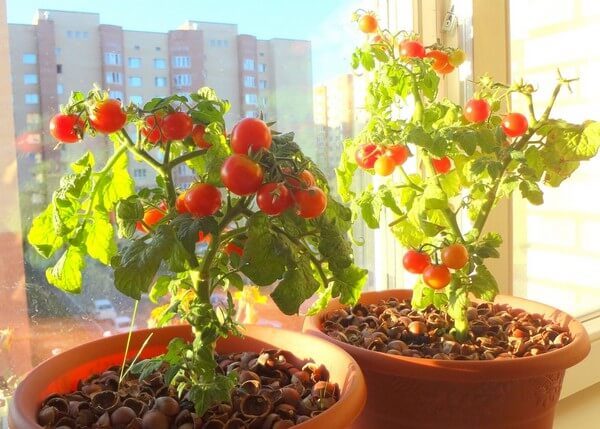

Standard bushes of mini-tomatoes
In the process of growth, remove weak and lagging plants in development, transplant strong specimens that interfere with each other in a separate container. Do not forget about feeding: regularly sprinkle with ashes and mulch the soil with humus, rotted grass, once a week fertilize with purchased formulations based on guano (bird droppings), humates or vermicompost.
Video: how to grow balcony tomatoes:
Homemade cucumbers from the balcony garden
Cucumber is famous for the most capricious character among balcony cultures. He does not tolerate drafts, is picky about the composition of the land mixture, needs intense lighting (cucumbers usually do not take root on the northern balconies), every now and then he strives to get sick. But, having got used to it, you will get a decent harvest of zelents - you can collect 5-7 kg from one bush.


Preparing seeds for germination
If you do not plan to light up your garden on the balcony, start planting in May, when daylight hours lasts at least 10 hours.Pre-germinate the cucumber seeds - put them on wet gauze and wait until small sprouts emerge from the "spouts". Place the soil only in a disinfected container, for example after holding it over a pot of boiling water.
Your further actions should look like this:
- Sow the seeds into a container to a depth of 1.5–2 cm. Do it carefully - the seedlings are very tender.
- Cover crops with translucent material and place containers on the balcony or in another place with a plus temperature of 24-26 °.
- As the top layer of the earth dries up, spray it with a sprayer.
With correct agricultural technology, seedlings will appear on the 6th day or a little earlier. You can already remove the film or glass, but be sure to maintain a warm and humid microclimate near the sprouts. After 2-3 weeks, when 2-3 true leaves appear on the stems, gradually harden the plants and prepare them for moving to the balcony (if they were originally planted in the room). Open the window for this, ventilate the room, turn off the heaters.
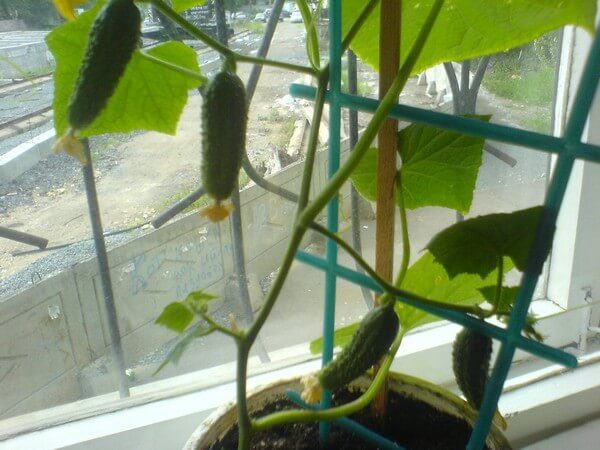

Cucumber on a trellis
As soon as it gets warmer + 15 ° on the balcony, move the containers here. After 5-6 sheets appear, tie the vines to a plastic trellis or to a stretched string. Protect them from overheating and hypothermia, shade them in time or, conversely, wrap the plants. Remember that they strongly dislike drafts and consume a lot of water, water and spray cucumbers daily.
Video: real experience of growing cucumbers on the balcony:
Growing strawberries on the balcony
Having seen the price of berries in the “off-season” in the supermarket, one may decide that growing them is difficult and expensive. In fact, strawberries take root quite easily on a balcony or windowsill with a constant temperature of + 18 °. Remontant varieties (capable of blooming and bearing fruit repeatedly during one growing season) have adapted well to urban conditions:
- "Queen Elizabeth";
- Clery;
- "Supreme";
- "Home Delicacy".


Garden strawberry seedling
Buy seedlings in a store, but it is better to take from friends or even grow from seeds. Choose a universal soil mixture - for home flowers, and containers should have a volume of at least 3 liters. The seed planting process is very simple:
- Lightly compact the prepared soil with a plank.
- Make shallow grooves in it.
- Using tweezers or a sharpened stick, sow the berry grains 2 cm apart.
- Place grade beacons if necessary.
Please note that the seeds will sprout for a long time, they need to be regularly moistened with a spray bottle. To reduce evaporation of moisture, cover the strawberry garden with plastic and ventilate it daily. Keep pots with seedlings in the brightest and warmest place. If you see that they do not receive the minimum required 12 hours of light, give them an artificial sun in the form of backlighting with a fluorescent lamp.


Strawberry sprouts
With ready-made seedlings, the life of a balcony gardener is even easier. You need:
- Prepare a solution of 1 tablet of heteroauxin (organic growth stimulant) and 5 liters of water.
- Trim the longest roots and place the plants in the solution for 3-4 hours.
- Plant each seedling, half burying its underground stem.
- Water the plantings with the prepared heteroauxin solution.
2 weeks after planting or the appearance of the first shoots, feed with complex mineral fertilizer. Spraying the leaves with a liquid solution of iron, which is usually sold in flower shops, does not hurt - iron increases the yield of strawberries. As a result, you will grow bushes capable of producing tasty, aromatic berries all year round.
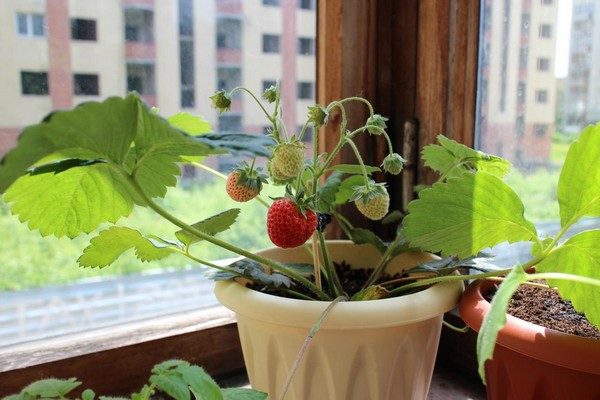

Ripe and still green berries
Choosing the time for landing


garden on the open balcony
So, you have already decided what you want to plant in your balcony garden.Now you need to choose the most optimal time for planting crops. This directly depends on the location of the balcony in relation to the cardinal points and the main source of illumination - the sun. Most of the heat and light is on the south side, on such a balcony you can plant the first plants already at the end of April. The western side allows planting only in early May, while the northern side allows planting in June. If you want to speed up the result, you can not plant seeds, but seedlings, which you can also grow or buy. In order for the plants to grow evenly, you need to turn them over to the sun on the other side every couple of days.
Balcony garden design - photo ideas
Even dacha landings today are customary to decorate. Needless to say about the garden on the balcony - I want to share photos of home beds and brag about them in front of guests as a landmark of my home. Here are some ways to combine practical benefits with spiritual beauty:
- be sure to put the containers used in order - paint the pots and boxes with bright paint (you can even use nail polish), decorate with a mosaic of ceramic shards or buttons, wrap with twine or textured yarn;
- to increase the usable area, use the principle of vertical beds - put open shelves, install a wooden shelf or curly trellis net, make decorative fences;
- as a base, use all sorts of scrap materials - construction pallets, cut lengthwise or installed on the end of plastic pipes, flower or household shelves.
Do not overdo it with compaction - all plants should be spacious and light. It is also important to consider crop compatibility when planting them side by side. So, tomato, basil and radish do not like to grow next to cucumbers, fennel "quarrels" with spinach, and carrots - with dill.
To make fewer mistakes, get ideas from experienced gardeners who willingly share their experience in growing vegetables and berries in mini-gardens on balconies and window sills. Do not neglect the little things, provide favorable climatic conditions for the plants, and they will thank you with a generous harvest.
Examples of garden design on the balcony:
Cooking seeds for planting
If you decide to create a vegetable garden "from scratch", that is, start with seeds, then they need to be prepared in advance in order to harvest a larger crop. Some seeds require pre-soaking for a day, especially for carrots or seeds with a dense shell or the presence of essential oils. Wrap them in cheesecloth, dip them in water. Place a container of water in a dark place. For example, cucumber seeds should be soaked for 12 hours. Remember that every 3-4 hours you need to change the water, and sometimes remove the seeds themselves to get oxygen.
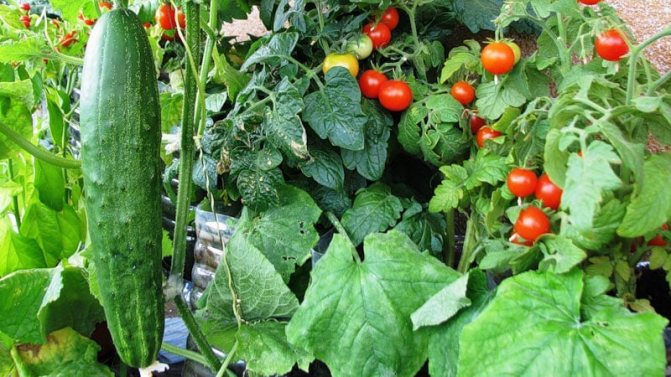

all this can be grown on the balcony
You can plant seeds that are already germinated to make sure they will provide inputs. To do this, take a saucer, put a glass plate on it. Sprinkle the seeds on the cheesecloth, pour a little water over the saucer, do not wet the plate. The ends of the gauze will absorb moisture and the seeds will germinate.


